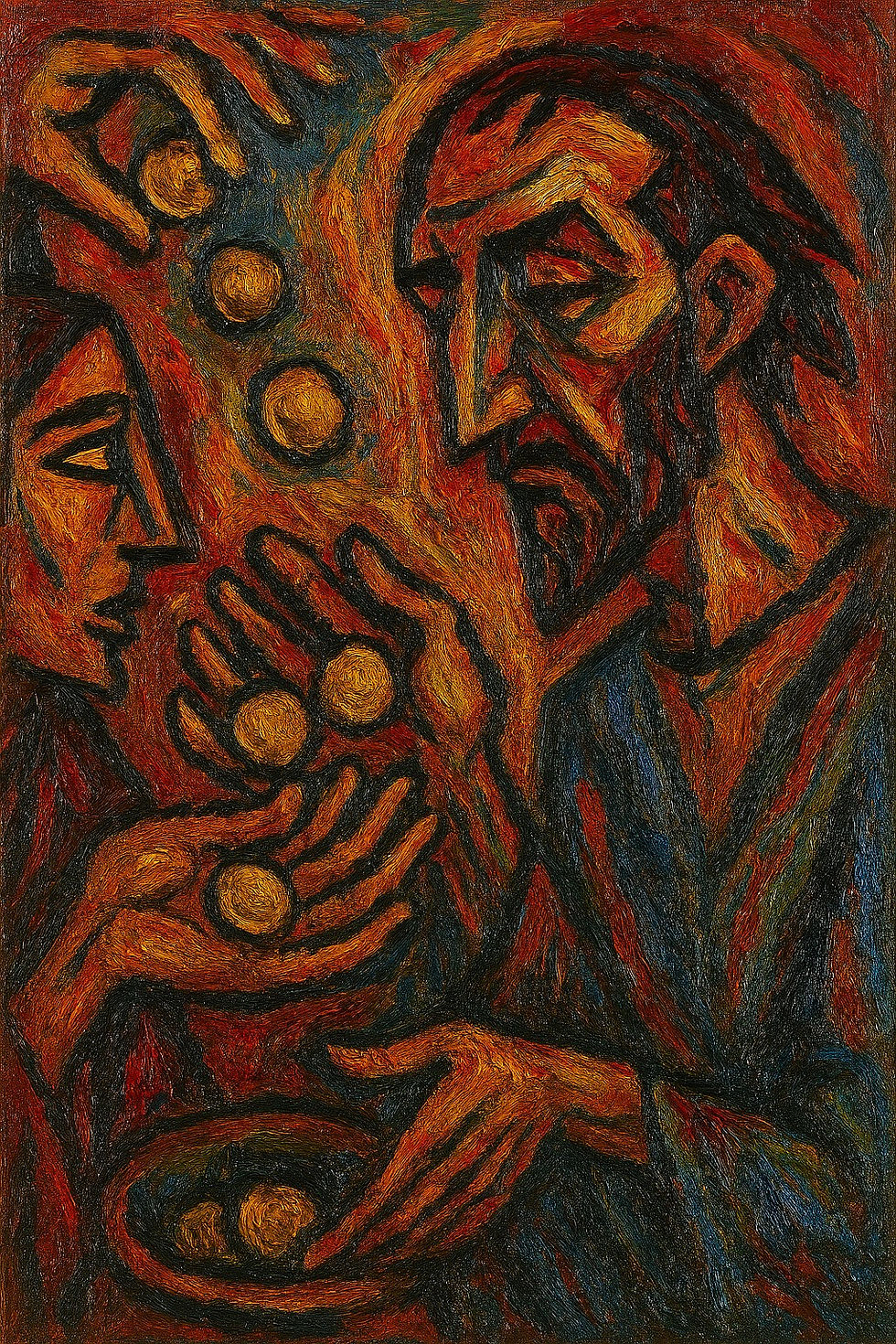Molecular Mechanisms of Information Processing in the Human Retina
- Martin Döhring

- 10. Okt.
- 5 Min. Lesezeit
The human retina is a multilayered neural tissue at the back of the eye that converts light into electrical signals, performing initial visual processing before transmission to the brain via the optic nerve. It consists of five main neuronal types: photoreceptors (rods and cones), horizontal cells (HCs), bipolar cells (BCs), amacrine cells (ACs), and retinal ganglion cells (RGCs), interconnected by synapses in the outer plexiform layer (OPL) and inner plexiform layer (IPL). Information processing occurs at the molecular level through phototransduction (light detection in photoreceptors), synaptic transmission (glutamatergic from photoreceptors/BCs to downstream cells), and lateral/modulatory interactions (inhibitory GABAergic/glycinergic from HCs/ACs). This enables parallel channels for features like contrast, color, motion, and luminance. Rods (~120 million per retina) handle scotopic (low-light) vision, while cones (~6 million, concentrated in the fovea) support photopic (bright-light, color) vision. Below, I detail these mechanisms step-by-step, focusing on key proteins, signaling cascades, and their roles in processing.

#### 1. Phototransduction: Light Detection and Hyperpolarization in Photoreceptors
Phototransduction is the initial biochemical conversion of photons into electrochemical signals in the outer segments of rods and cones. In darkness, photoreceptors are depolarized (~-40 mV) due to a "dark current" of Na⁺/Ca²⁺ influx, leading to continuous glutamate release at OPL synapses. Light absorption triggers a G-protein-coupled cascade that hydrolyzes cGMP, closing ion channels and hyperpolarizing the cell (~-70 mV), reducing glutamate release. This encodes light intensity and wavelength. The cascade amplifies signals: one photon activates ~500 transducins, each hydrolyzing ~1,000 cGMP molecules.
Key Steps in the Cascade:
1. Photon Absorption by Opsins: Light isomerizes 11-cis-retinal (bound to opsin in disc membranes) to all-trans-retinal, activating the holopigment (rhodopsin in rods; iodopsins in cones). Rhodopsin (peak 500 nm) enables single-photon sensitivity in rods; cone opsins (erythrolabe 565 nm/red, chlorolabe 535 nm/green, cyanolabe 440 nm/blue) support trichromatic color vision.
2. G-Protein Activation (Transducin): Activated opsin catalyzes GDP-GTP exchange on transducin (Gαt heterotrimer), releasing activated Gαt-GTP.
3. cGMP Hydrolysis by PDE6: Gαt-GTP activates phosphodiesterase 6 (PDE6), hydrolyzing cGMP to 5'-GMP. In darkness, high cGMP (~5–10 μM) keeps cyclic nucleotide-gated (CNG) channels open.
4. Channel Closure and Hyperpolarization: CNG channels (heterotetramers of CNGA1/CNGB1 in rods, CNGA3/CNGB3 in cones) close, halting Na⁺/Ca²⁺ influx while K⁺ efflux (via inner segment channels) continues, hyperpolarizing the cell and reducing glutamate release.
5. cGMP Restoration: Guanylate cyclases (ROS-GC1/2) synthesize cGMP from GTP, activated by guanylate cyclase-activating proteins (GCAPs) when Ca²⁺ drops.
Differences Between Rods and Cones:
| Aspect | Rods | Cones |
|--------|------|-------|
| Pigment | Rhodopsin (1 type, high sensitivity) | Iodopsins (3 types, color-specific) |
| Outer Segment | Isolated discs for efficient signaling | Continuous membrane invaginations for faster diffusion |
| Kinetics | Slow recovery (saturates in bright light) | Fast responses/adaptation (operates in bright light) |
| Amplification | Higher (~10^5-10^6 ions/photon) | Lower but faster (~10^3 ions/photon) |
| Synaptic Output | Convergent (multiple rods → 1 BC) for sensitivity | Divergent (1 cone → multiple BCs) for acuity |
Regulatory Mechanisms (Ca²⁺ Feedback):
- Light reduces Ca²⁺ influx via CNG closure; low Ca²⁺ activates GCAPs to boost cGMP synthesis (negative feedback for recovery).
- Recoverin (Ca²⁺-binding protein) inhibits rhodopsin kinase at high Ca²⁺, prolonging activation for sensitivity; low Ca²⁺ allows phosphorylation by rhodopsin kinase, enabling arrestin binding to quench opsin.
- Regulators of G-protein signaling (RGS9) accelerate transducin GTPase activity for rapid deactivation.
Human mutations (e.g., rhodopsin in retinitis pigmentosa) disrupt folding/trafficking, causing rod degeneration and night blindness.
This hyperpolarization modulates glutamate release, inverting or preserving the signal in BCs for parallel processing.
#### 2. Synaptic Transmission: Photoreceptors to Bipolar Cells (Outer Retina)
Photoreceptor terminals (rod spherules, cone pedicles) form ribbon synapses in the OPL with ~10–20 BC dendrites and HC processes, releasing glutamate tonically. Reduced release (light-induced hyperpolarization) drives ON pathway activation and OFF suppression. Key: multipartner ribbon synapses for sustained, high-fidelity release.
Molecular Components:
- Ribbon Proteins: Ribeye (anchors synaptic vesicles), Bassoon (active zone scaffold). Mutations shorten ribbons, impair glutamate release, and disrupt ERG b-waves (ON BC response).
- Calcium Channels: CaV1.4 (L-type) triggers release; α2δ4 auxiliary subunit stabilizes channels. KOs retract terminals, lose invaginations, and abolish rod→BC transmission.
- Adhesion Proteins (LRR Family): ELFN1 (rods, binds mGluR6/CaV1.4), ELFN2 (cones), LRIT1/3 (organize postsynaptic complexes). ELFN1 KOs eliminate rod invaginations and b-wave; LRIT3 KOs abolish ON BC responses via TRPM1/mGluR6 loss.
- Receptors and Signaling:
- ON BCs: Metabotropic mGluR6 (sign-inverting: low glutamate → depolarization via G/o closure of TRPM1 cation channels). Complex: mGluR6-RGS7/11-Gβ5-GPR179-nyctalopin-TRPM1. Mutations (e.g., nyctalopin in night blindness) prevent trafficking, losing invaginations.
- OFF BCs: Ionotropic AMPA/kainate receptors (GluR2/4; sign-preserving: low glutamate → hyperpolarization).
- ECM Proteins: Pikachurin (dystroglycan ligand in cleft) stabilizes invaginations; KOs impair ERG across light levels.
- HC Modulation: HCs provide feedback inhibition via ephaptic (Ca²⁺-dependent) and GABAergic mechanisms, enhancing contrast. Proteins: AMIGO1 (HC axon growth), NGL2 (Netrin-G2 binding for rod synapses).
These form parallel channels: rods → rod BCs (RBCs) for scotopic vision; cones → ON/OFF cone BCs (CBCs) for photopic. Activity-dependent: glutamate release localizes mGluR6; dark-rearing reduces clustering.
#### 3. Inner Retinal Processing: Bipolar Cells to Ganglion Cells (IPL)
BC axons form ribbon synapses in the IPL with RGC dendrites and AC processes, stratified into ON (sublamina b) and OFF (sublamina a) layers. ~13 BC types relay to >20 RGC types, with ACs (~30 types) adding inhibition for feature extraction. Glutamate from BCs excites RGCs; reduced BC release (light for ON, dark for OFF) drives responses.
Molecular Components:
- Ribbon Synapses: Similar to OPL (Ribeye, Bassoon, Complexins 3/4 for release fidelity). Complexin KOs impair rod signaling.
- Adhesion Proteins: LRRTM4 (clusters GABA receptors on RBCs for inhibition); Fat3 (cadherin for AC/RGC lamination). KOs disrupt dyads (BC→AC/RGC triads) and direction selectivity.
- Receptors:
- Excitatory (RGCs): Ionotropic GluRs (AMPA/NMDA for ON/OFF).
- Inhibitory (ACs): GABA_A/C (α2/3 subunits, clustered by Neuroligin-2/3, gephyrin) and GlyRs (α1, Neuroligin-4). GABA_Aα2 essential for direction tuning; KOs reduce clustering, alter dyads.
- Modulation: Cholinergic (β2-nAChRs from starburst ACs [SACs]) for waves/refinement; dopaminergic ACs for adaptation.
HC/AC Roles in Lateral Processing:
- HCs: Surround inhibition in OPL, depolarizing to light surrounds via gap junctions (connexins) and GABA release, sharpening edges.
- ACs: Wide-field (e.g., SACs) provide asymmetric GABA release for direction selectivity (DS) in DS-RGCs; narrow-field for temporal tuning. SACs use glutamate/GABA co-release; β2-nAChR KOs truncate waves, impair DS.
Activity-dependent: Inhibitory release regulates receptor clustering; BC ablation rewires RGCs homeostatically, preserving responses.
#### 4. Parallel Information Processing Channels
The retina creates ~12–20 parallel channels from OPL divergence, enabling feature-specific output:
| Channel | Molecular Basis | Function |
|---------|-----------------|----------|
| ON Pathway | mGluR6-TRPM1 in ON BCs; invaginating synapses (ELFN1/LRIT3). | Light increments → BC depolarization → RGC excitation; luminance increase detection. |
| OFF Pathway | Ionotropic GluRs in OFF BCs; basal synapses. | Light decrements → BC hyperpolarization → RGC excitation; contrast edges. |
| Color Opponency | Cone-specific BCs (e.g., blue-OFF via S-cone Neurexin3); HC mixing. | Red-green/blue-yellow via cone opsin segregation; midget RGCs. |
| Direction Selectivity | SAC asymmetric GABA (GABA_Aα2/Neuroligin-3); cholinergic input. | Motion direction via null-side inhibition; DS-RGCs. |
| Rod vs. Cone | ELFN1 (rods) vs. ELFN2 (cones); Pikachurin for invaginations. | Scotopic (rods→RBC→AII AC→ON CBCs) vs. photopic pathways. |
ON-OFF antagonism (push-pull via reciprocal AC inhibition) enhances contrast; motion via SAC-RGC asymmetry. Human fovea emphasizes cone channels for acuity.
#### Output and Integration
RGC axons form the optic nerve (~1 million fibers), with types like midget (color/fine detail), parasol (motion), and bistratified (blue-yellow). Processing refines receptive fields (center-surround via HC/AC), compressing data ~100-fold. Mutations (e.g., in adhesion proteins) cause congenital blindness, highlighting molecular precision.
This molecular architecture ensures efficient, parallel visual encoding, with feedback/plasticity maintaining function.








Kommentare